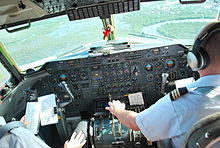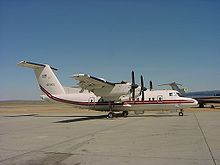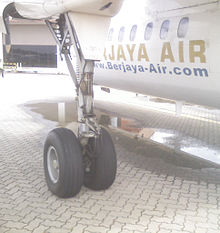- de Havilland Canada Dash 7
-
"Dash 7" Adria Airways Dash 7 in 1989 Role Regional STOL airliner Manufacturer de Havilland Canada, Toronto First flight March 27, 1975 Introduction February 3, 1978 Status Active service Primary users Various airlines
Canadian Forces
United States Army
Venezuelan NavyProduced 1975-1988 Number built 113 Developed from DHC-6 Twin Otter Developed into de Havilland Canada Dash 8 The de Havilland Canada DHC-7, popularly known as the Dash 7, is a turboprop-powered regional airliner with STOL capabilities. It first flew in 1975 and remained in production until 1988 when the parent company, de Havilland Canada, was purchased by Boeing and was later sold to Bombardier. Bombardier sold the aircraft design (type certificate) to Viking Air in 2006.
Contents
Design and development
In the 1960s, de Havilland Canada was already well known worldwide for their series of high-performance STOL aircraft, notably the very popular Twin Otter. However, these aircraft were generally fairly small and served outlying routes, as opposed to the main regional airliner routes which were already well served by larger, higher-performance aircraft such as the Handley Page Jetstream and Fokker F27.
The de Havilland Canada company felt they could compete with these designs in a roundabout way. With their excellent STOL performance, their designs could fly into smaller airports more centrally located in city centres, with runways that the other aircraft could not easily use. The original specification called for a 40-passenger aircraft with a fairly short range of 200 statute miles, operating from runways only 2,000 ft long (610 m).
With new noise restrictions coming into effect throughout the 1970s, an aircraft tailored for this role would also have to be very quiet. To meet this restriction, the new design used oversized propellers geared to spin at a slower speed than normal; much of the sound from a propeller is generated at the tips which are spinning near the speed of sound, and therefore, by reducing the number of RPM, this noise is reduced substantially. The Dash 7 often landed with only 900 rpm, and took off at only 1,210.
In other respects, the new DHC-7 was essentially a larger, four-engine version of the Twin Otter. The general layout remained similar, with a large T-tail intended to keep the elevator clear of the propwash during take-off, a high aspect ratio high-mounted wing, and most details of the cockpit and nose profile. Changes included the addition of cabin pressurization which required a switch to a fuselage with a circular cross-section and landing gear that folded forward into the inner engine nacelles.
The Twin Otter incorporated "flapperons" that drooped the ailerons as part of the flaps, but these were not included in the Dash 7 due to weight and complexity. Instead the ailerons were reduced in size to allow more flap area, and were augmented with two sets of roll-spoilers. The inboard roll spoilers operate at all speeds while the outboard roll spoilers only operate at speeds less than 130KIAS to allow for more roll control at slower speeds. Upon touchdown both the inboard and outboard roll spoilers extend in unison to aid in destroying lift created by the wing. Each wing also includes two ground spoilers which only extend on touchdown. Most of the rear wing was spanned by a complex double Fowler flap arrangement for high lift at low speed. During a typical STOL landing flaps would be selected to the 45° position. This flap setting allowed for steeper descents and slower approach speeds. Depending on weight the VREF speed with flaps at 45° would be between 70-85 knots. On touchdown, through switches in the main gear, the flaps would automatically retract to the 25° position and thus reduce lift once on the runway for better braking performance. The flaps would also retract to 25° when engine power was increased during a go-around procedure.[citation needed] The four-engine layout aided lift at low speeds due to the wide span of the propellers blowing air over the wing. When reverse thrust was selected on landing, the props push air forward and slow the airplane effectively along with the anti-skid wheel brakes. More importantly, if an engine failed, the asymmetric thrust was much less than on a twin-engine layout, thereby increasing safety and allowing for a lower minimum control speed with an engine inoperative (VMC).
Operational history
 DHC-7 of London City Airways making its steep approach to London City Airport as another loads before departure to Amsterdam in 1988
DHC-7 of London City Airways making its steep approach to London City Airport as another loads before departure to Amsterdam in 1988
Development started in 1972 and the prototype first flew on March 27, 1975. Testing went smoothly, and the first delivery took place to Rocky Mountain Airways on February 3, 1978. One hundred were delivered by 1984, when the production line was put on hold in favour of the Dash 8. Another 13 were delivered between 1984 and 1988, when the production lines were removed when Boeing bought the company.
The original Series 100 represents the vast majority of the aircraft delivered, and came in two models; the -102 passenger version and -103 combi with an enlarged cargo door. These were followed by the Series 110 which met British CAA requirements, including the -110 and -111, and finally the Series 150 which included additional fuel tankage and an improved interior in the -150 and -151. There were plans for a Series 200 with the new PT6A-50/7 engines which improved hot-and-high power, but these plans were shelved when Boeing ended production of the design.
The mixture of features on the Dash 7 met with limited commercial success. Most turboprop operators used them as feederliners into large airports, where the STOL performance wasn't considered important. In comparison to other feederliners, the Dash 7's four engines required twice the maintenance of a twin-engine model, thereby driving up operational costs. Finally, those airports that did require a high performance STOL operation were generally small and well served by the Twin Otters; had the airport needed a larger plane to serve its customer base, they would have built larger runways. One exception to this was operations at London City Airport which, upon opening in 1987, was capable of handling few aircraft types besides the Dash 7.
The Dash 7 also gained a number of military orders. The first of these was for two aircraft for the Canadian Armed Forces, who needed them to transport high ranking passengers and freight around Europe. These aircraft received the CF designation CC-132 and were delivered to No.412 Squadron at Lahr, in West Germany.[1]
The United States Army operates several Dash 7 aircraft as surveillance platforms with the designation EO-5C (RC-7B before 2004)[2] under the Airborne Reconnaissance Low program.
Transport Canada operates a single DHC-7-150IR aircraft to conduct maritime surveillance, pollution and ice patrols as part of the Transport Canada National Aerial Surveillance Program (N.A.S.P.). The aircraft's home base is Ottawa, Ontario, Canada. During the summer months this aircraft conducts patrols throughout the Canadian Arctic, Alaska and Greenland. During the fall and winter months this aircraft conducts patrols of the Great Lakes and east or west coasts of Canada as required.
The design of a much more "conventional" twin-engine design commenced at de Havilland in 1978, resulting in the extremely popular Dash 8. The DHC-7 production line eventually delivered 113, of which four have been lost and one scrapped.[citation needed] Many of the rest remain in service.
Variants
- DHC-7-1
- Prototypes, two built.
- DHC-7-100
- Production passenger variant with a maximum of 54 passengers (with 43,000 lb/20,000 kg takeoff weight).
- DHC-7-101
- Production passenger/cargo variant with a maximum 50 passengers and a left hand forward cargo door (with 43,000 lb/20,000 kg takeoff weight).
- DHC-7-102
- Production passenger variant with a maximum of 54 passengers (with 44,000 lb/20,000 kg takeoff weight).
- DHC-7-103
- Production passenger/cargo variant with a maximum of 50 passengers and a left hand forward cargo door (with 44,020 lb/19,970 kg take-off weight.
- DHC-7-110
- DHC-7-102 certified for use in the United Kingdom.
- DHC-7-111
- DHC-7-103 certified for use in the United Kingdom.
- DHC-7-150
- Improved 1978 version with higher gross weight, increased fuel capacity and improved passenger amenities,
- DHC-7-150IR
- One series 150 modified in 1986 for Transport Canada for Ice/Pollution patrols of the Canadian Arctic.
- CC-132
- Canadian military designation for the Series 102/103
- O-5A (RC-7 ARL)
- Converted by California Microwave Incorporated 1991-92
- EO-5B (ARL-C)
- United States military designation for Series 102
- EO-5C (RC-7B)
- Converted by California Microwave Incorporated 1996
Accidents and incidents
The de Havilland Canada DHC-7 has been involved in six accidents (and 10 incidents overall) with a total of 68 fatalities.[3]
- April 28, 1982 - Aerovías Nacionales de Honduras DHC-7-103 hijacked at Le Ceiba-Goloson International Airport in Honduras with no lives lost[4]
- May 9, 1982 - Alyemda DHC-7-103 crashed into sea near Aden International Airport in Yemen killing 23 of 49 on board.[5]
- June 23, 1982 - Henson Airlines DHC-7 hijacked at Staunton-Shenandoah Valley Airport, in Virginia with no lives lost.[6]
- February 15, 1983 - Rio Airways Flight 252 DHC-7-102 hijacked at Nuevo Laredo, Mexico with none of 20 on board injured.[7]
- May 6, 1988 - Widerøe Flight 710 DHC-7-102 crashed on a hillside during poor weather near Brønnøysund Airport in Norway, killing 36 on board.[8]
- November 28, 1998 DNK Aviation Leasing Group DHC7-102 crashed after engine failed during a test flight near Ashburton, United Kingdom killing the crew of 2.[9]
- July 23, 1999 - US Army DHC-7-102 (O-5A) crashed into mountain near Orito in Putumayo province in Colombia killing all seven on board.[10]
- September 7, 1999 - Skyline (Nigeria) DHC-7-102 damaged from belly landing at Port Harcourt Airport in Nigeria with 19 on board (no fatalities).[11]
- September 4, 2002 - Asian Spirit Flight 897 DHC-7-102 slid off runway at Manila-Ninoy Aquino International Airport with 49 on board (no fatalities).[12]
- May 1, 2006 - Trans Capital Air (Toronto based charter company) for United Nations Mission in Liberia (UNMIL) DHC-7-102 crash-landed at Zwedru Airport in Liberia after landing gear failed to extend, with 40 on board (37 Ethiopian soldiers) uninjured.[13]
Operators
Airline operators
As of September 12, 2008, a total of 68 Dash 7 aircraft (all variants) remain in airline service.[14]- Air Greenland (6)
- Arkia (4)
- Airkenya Express (2)
- Aviones Comerciales de Guatemala (Avcom) (1)
- Aéro Ruta Maya (1)
- Berjaya Air (3)
- Conviasa (1)
- Linea Turistica Aerotuy (2)
- Helicol (1)
- Air Tindi (3)
- Transport Canada (1)
- Voyageur Airways (6)
- Trans Capital Air (9)
Former operators
- Tyrolean Airways (2)
- AirBC
- Time Air
- City Express
- Wardair (2) (both named 'Don Braun')
- Widerøes Flyveselskap (11)
- DNK Aviation Leasing Group
- Asian Spirit (3)
- Adria Airways (2)
- Brymon (12)
- Eurocity Express (2)
- London City Airways (4)
- Air Wisconsin Airlines (13)
- Henson Airlines
- Ransome Airlines (8)
- Alyemda (3)
- Air Nuigini
Other civilian operators
The British Antarctic Survey (BAS) operates a single Dash 7 in support of its research program in Antarctica. The aircraft undertakes regular shuttle flights between either Stanley on the Falkland Islands, or Punta Arenas in Chile, and the Rothera Research Station on Adelaide Island. It also operates to and from the ice runway at the Sky Blu Logistics Facility on the Antarctic mainland.[15] Kaiken Líneas Aéreas also operated two Dash 7s between Tierra del Fuego and Santa Cruz, in Argentina.
A single DHC-7 150IR is owned and operated by Transport Canada conducting coastal pollution and ice patrols across the Canadian Arctic.
Military operators
- Canadian Forces (two delivered 1979, flown until 1987)[16]
- United States Army (10 - 1 O-5A, 2 EO-5B, 5 RC-7B)[16]
- Venezuelan Navy (one delivered in 1982)
Specifications
General characteristics
- Crew: 2
- Capacity: 50 passengers
- Length: 80 ft 7¾ in (24.58 m)
- Wingspan: 93 ft 0 in (28.35 m)
- Height: 26 ft 2 in (7.98 m)
- Wing area: 860 ft² (80 m²)
- Empty weight: 27,650 lb (12,540 kg)
- Max takeoff weight: 44,000 lb (20,000 kg)
- Powerplant: 4 × Pratt & Whitney Canada PT6A-50 turboprops, 1,120 shp (835 kW) each
Performance
- Maximum speed: 235 knots (271 mph (436 km/h))
- Range: 700 nm (770 mi (1,240 km))
- Service ceiling: 21,000 ft (6,400 m)
See also
- Related development
- de Havilland Canada DHC-6 Twin Otter
- de Havilland Canada Dash 8
- Aircraft of comparable role, configuration and era
- ATR 72
- Dornier 328
- Fokker F27
- Fokker F50
- Saab 2000
- Antonov An-24
- Related lists
- List of airliners
References
- Notes
- ^ "de Havilland CC-132 Dash 7." Canada's Air Force, April 6, 2004. Retrieved: August 27, 2008.
- ^ "Non-Standard DOD Aircraft Designations." designation-systems.net. Retrieved: October 18, 2009.
- ^ Aviation Safety Network Database - de Havilland Canada DHC-7 Aviation Safety Net
- ^ "Accident Report 19820428-0." Aviation Safety Net. Retrieved: October 18, 2009.
- ^ "Accident Report 19820509-1." Aviation Safety Net. Retrieved: October 18, 2009.
- ^ "Accident Report 19820623-0." Aviation Safety Net. Retrieved: October 18, 2009.
- ^ "Accident Report 19830215-0." Aviation Safety Net. Retrieved: October 18, 2009.
- ^ "Accident Report 19880506-0." Aviation Safety Net. Retrieved: October 18, 2009.
- ^ "Accident Report 19981128-0." Aviation Safety Net. Retrieved: October 18, 2009.
- ^ "Accident Report 19990723-1." Aviation Safety Net. Retrieved: October 18, 2009.
- ^ "Accident Report 19990907-0." Aviation Safety Net. Retrieved: October 18, 2009.
- ^ "Accident Report 20020904-0 ." Aviation Safety Net. Retrieved: October 18, 2009.
- ^ "Accident Report 20060501-0." Aviation Safety Net. Retrieved: October 18, 2009.
- ^ "DHC-7 Record." CH-Aviation. Retrieved: October 18, 2009.
- ^ "Aircraft in Antarctica." British Antarctic Survey. Retrieved: December 31, 2007.
- ^ a b "Canadian Aerospace — Background — DeHavilland Canada Dash 7." Canadian American Strategic Review via Archive, October 11, 2009. Retrieved: October 18, 2009.
- Bibliography
- Hotson, Fred W. The De Havilland Canada Story. Toronto: Canav Books, 1983. ISBN 978-096907032-0.
External links
de Havilland Canada aircraft DHC-1 · DHC-2 · DHC-3 · DHC-4 · DHC-5 · DHC-6 · DHC-7 · DHC-8
CS2F Tracker · Gipsy Moth · Tiger Moth · Fox Moth · Mosquito
Canadian Forces unified aircraft designations post-1968 100-125 126–150 151- United States tri-service observation aircraft designations post-1962 Lists relating to aviation General Aircraft (manufacturers) · Aircraft engines (manufacturers) · Airlines (defunct) · Airports · Civil authorities · Museums · Registration prefixes · Rotorcraft (manufacturers) · TimelineMilitary Accidents/incidents Records Categories:- Canadian airliners 1970–1979
- De Havilland Canada aircraft
Wikimedia Foundation. 2010.







